According to some, it’s still up for discussion just who was the world’s fastest rider in 2022. A glance at the MotoGP World Championship table sees Francesco Bagnaia’s name right at the top after 20 races played. Yet even when his hair was still matted from the victory champagne sprayed after securing Italy’s first premier class crown in 13 years, the 25-year-old was openly admitting there were more complete riders than him on the grid.
After the longest season in history, there could be no doubt that Bagnaia won aboard the grid’s best bike. In the second half of 2022, the premier class hadn’t witnessed such dominance from one manufacturer – 12 wins, 32 podiums, 16 pole positions – spread among Ducati’s fleet of eight riders since Honda’s brilliant five-cylinder RC211V was laying waste to the opposition in 2003. In crunch moments, Bagnaia could call upon able backup when his chief rival was battling all alone.
And there remains the argument that Quartararo’s refusal to give in despite the drastic shortcomings of his underpowered Yamaha YZR-M1 was worthy of greater admiration. The average points Bagnaia scored per race (13.25) is the second lowest since the current point-scoring system was introduced in 1993 (only Joan Mir in 2020 was lower on the Suzuki).

Yet that’s not to say Bagnaia isn’t a worthy champion – far from it. If we scan the numbers, questioning the validity of his crown isn’t even an argument worth making: the rider from Turin in the north of Italy didn’t just outscore Quartararo in terms of points (265 to 248); he did so in all the other metrics that matter: wins (seven to three), podiums (10 to eight), pole positions (five to one), and front row starts (10 to five). Plus, he took the title despite not finishing a quarter of the year’s
20 races – a new first.
More impressive still was the manner in which he won six of his seven victories. A stroll at Assen aside, Bagnaia’s biggest winning margin all year long was 0.7sec. Not once was he afforded a smooth ending, with the last-lap pressure asserted on him at Jerez, Silverstone, Misano and Sepang as intense a scrutiny as any champion could imagine. On each occasion, Bagnaia held his nerve. And when it was starlet Enea Bastianini sniping from behind, it was hard to argue all of Ducati was united behind him.

“This year I was always with a lot of pressure from behind,” Bagnaia said of his title triumph. “Enea was fast behind me, trying to overtake and I was trying to manage the situation. It’s one where you can easily lose your concentration. But I think we worked well.
“At the (Valentino’s) ranch, we are always together, fighting like this, putting a lot of pressure on each other. So, this helps in these situations.”
And after his last major blunder in Japan, the next three outings in Thailand, Australia and Malaysia, replete with strange conditions and unpredictable forecasts, offered opportunities aplenty for a crucial mistake. Yet Bagnaia tackled each one of these rounds like a champion. Even serial champion Marc Marquez was moved to commend Bagnaia’s win-it-or-bust approach at the round in Sepang.

“Believe me, it’s not easy when you are fighting for a championship, not easy. [But] He took a risk and did it,” said the Catalan.
More impressive than any of that was where he found himself after Germany. A fourth crash in 10 saw him all at sea in the championship, 91 points back of Quartararo, displaying the swashbuckling form that carried him to the 2022 crown. Yet this was the point in which Bagnaia took stock and regrouped. From then his form was devastating. In 10 races, he amassed 197 points from an available 250. His six wins and eight podiums in 10 saw him average 19.7 points per race – numbers that Marquez in his pomp would have been proud of.

In 74 years of premier class competition, a rider has never recovered from so far back. Bagnaia smashed Wayne Rainey’s record for the biggest comeback, when the American triumphed in 1992 despite being 65 points behind Mick Doohan (the Aussie’s horrendous leg injury a major part of the shift in the balance of power). This is the standout point of Bagnaia’s title, and one that will ensure it is remembered in years to come.
“I just lost faith in the championship for like one hour after the race at the Sachsenring,” said the champion of 2022. “But from that moment, I knew there was still a chance. We tried to analyse everything, at home: what to improve, why I was crashing, why I was committing so many mistakes. But from that moment, we did something incredible.”

Shaky Start
Yet none of this seemed possible in the year’s opening stage as Bagnaia cut a largely exasperated figure through the first five grands prix. His polite, patient demeanour was replaced by a mardiness in dealings with the media.
The reasons behind this less-than-perky Pecco were glaringly clear: Ducati had ended 2021 in a tremendous position of strength, dominating the final race by locking out the front row and podium for the first time in history. Then followed that with a positive test at Jerez, where Bagnaia proclaimed “the old bike was perfect already and we are improving this perfect bike”.

But what arrived at the Sepang test in February was far from his – or any of the four other riders on the GP22 – liking. The engine was too peaky and aggressive. It offered little of the front-end stability in braking for which its predecessor was famed. And it seemed that the incessant tinkering of Gigi Dall’Igna, Ducati Corse’s General Manager, had gone too far. Yes, the ride-height device, first introduced in 2019, that lowered the rear of the bike on corner exit was quickly adopted by all the grid’s other bikes. But the new device, which lowered the front of the bike and was eventually abandoned by the factory team, required a complete change in riding technique.

Front feel is what Bagnaia depends on.
“He uses 100 percent of the front tyre,” said Dall’Igna of his rider’s strengths last year.” On his own style, Bagnaia offered, “I’m braking harder than the others, I can stop the bike more. When I enter the corners I’m in a better direction. I don’t need to let it turn with the rear sliding. I make it turn in braking and they [the others] do it on the exit.”

Thus, his sharpest tool was blunted. And it didn’t end there: Bagnaia was so displeased with Ducati’s 2022 engine in testing, he requested a dramatic change before the first race – both he and teammate Jack Miller would go back to “a slightly hybrid version between the ’21 and ’22 engine,” according to Sporting Director Paolo Ciabatti. But still it wasn’t done. Bagnaia and Ducati went to the first race chopping and changing parts and set-up. The lead rider was not amused. It underlined a weakness to which many could relate.
“He wants to come up with a base setup and then make very little changes to it,” admitted Ciabatti as Bagnaia laboured.

Still it got worse: Bagnaia was all over the place on Saturday in Argentina, repeatedly throwing his hands up in the air before Miller put a caring arm round his shoulder. That was before a painful qualifying crash in Portugal put his participation in that GP in some doubt. Their issues were exacerbated by the state of the grid: Yamaha was running the same underpowered bike as the previous year, while Honda and KTM were miles off. Ducati was standing in front of an open goal. The speed of the GP21 in Bastianini’s hands was an added insult. Free of testing responsibilities aboard a fully sorted bike, the Italian swept to three wins in the first seven races, a galling sight for those grappling to find a base setting with new hardware.

Alessio ‘Uccio’ Salucci, known as Valentino Rossi’s right-hand man through a 25-year stint in World Championship racing, and currently the Sporting Director of the VR46 Academy, does not, however, feel this was all Ducati’s doing.
“Sometimes one of Pecco’s problems is he is too optimistic,” explained Salucci. “When he first rode the ’22 bike at Jerez last November, he came to me and said: ‘Wow, it’s the best bike I’ve ever ridden!’ He started speaking to newspapers. I told him: ‘Pecco, no! I don’t like this. Keep a low profile.’ This isn’t good for Ducati because when a rider arrives and says, ‘the new bike was fantastic,’ the engineers say, ‘Perfect! The old project was shit!’

“The mistake of the first part of this year was last November. Then when we arrived in Malaysia in February, he tried the new bike and said: ‘In November it was the best bike, now it’s shit!’ In this moment, he realised the first five races would be really tough. But Pecco always remained focussed. He’s a clever rider also and when he put everything with the bike together in the right way, he could do what he did.”

The comeback
By Jerez, Ducati engineers had found a base setting that returned Bagnaia’s confidence when braking robustly on the front-end, where much of his work is done. But crashes out at Le Mans, when chasing Bastianini, and Barcelona, when taken out, negated those gains. Then came the season’s nadir at Sachsenring, when another careless fall left him really up against it.
At this point it wasn’t just the support of Ducati that came in: members of the VR46 Academy rallied around Bagnaia, and told him a few home truths about his predicament.
“In my situation I love when some people around me say what they think about me,” Bagnaia said of that moment. “I’m a difficult guy because at the start I say: ‘No, it’s not like that.’ Then I try to change my mindset, to change myself, taking that advice on board.” Salucci agreed: “(After Germany) he said he was stupid but he understood why he crashed. When a rider understands why he crashes, it’s easier to recover, to restart. Pecco stayed calm and the guys in the academy were together. The VR46 Academy grouped around him in that moment.”

“The most difficult moment was at the Sachsenring because I was very competitive,” Bagnaia explained. “Like in Le Mans, I was there with a possibility to win, but I crashed. In that moment, I recognised that my weak point was there, that I was a rider with a lot of ups and downs.” The French and German GP crashes were of a similar kind: when settling in behind the bike ahead, thinking too much of the final laps.
“In those two moments, I had said: ‘I will be calmer, breathe and then come back’. But right away I crashed,” he freely acknowledged at the Assen round. “Maybe with our bike, my feeling is that when you are not pushing on the tyres maybe it’s easier to crash.”

From then on, the only focus was the immediate job at hand. By then, it was clear the teething problems with Ducati’s GP22 were a thing of the past. Most in the factory felt a run of victories wasn’t beyond them.
“We never gave up in the very bad moments,” said Crew Chief Cristian Gabarrini. “It’s easy to be happy when everything is fine. But the trick is to be strong when everything goes wrong. Every person in this project never lost their focus, which was to win this championship. Pecco felt that and this was some additional momentum for him.”

The advice and support worked. Four races, which demonstrated his strongest attributes, namely tyre management and an exceptional late-braking ability, followed. Quartararo, meanwhile, had lost all of that mid-season assurance. He lost the ability to qualify on the front row, and misfortune stalked him at Aragon and Thailand. The wet encounter at the Chang International Circuit in Thailand was one that told Bagnaia the championship was his.
“Thailand was a very difficult race for me, I struggled a lot in the wet. But I tried everything to be on the podium and recovered a lot of points. In that moment, I recognised we could win it.”
Two races later he had 23 points in hand, a reversal of 114 in just nine outings. “That gave me the margin to control the gap.”

More to come?
It wasn’t just on-track where Bagnaia endured a tumultuous time. During the summer break, he crashed his car in Ibiza while driving over the blood alcohol limit. Unwise. But more perplexing was the reaction: both he and Ducati felt attacked when journalists had the temerity to quiz him about this misdemeanour at the next race.
And then there was the instance of his tribute helmet to basketball legend Dennis Rodman at his home race in Misano. Now the American may have twice been an NBA all-star, but he’s now better known for a close-knit relationship with North Korean dictator Kim Jong-un and the many cases of assault, sexual and otherwise, against his name. Again, Bagnaia’s response when quizzed on this didn’t point to a great deal of thought beyond the sporting sphere.

There was also the sense he wasn’t the most independent of spirits. The figure of Rossi often loomed large, with pre-race pep-talks from him, ex-factory test rider Casey Stoner (at Silverstone and Phillip Island) and teammate Miller (in Thailand) all needed at certain moments to maintain momentum in his fightback. Rossi’s comments after Bagnaia’s maiden premier class success at Aragon last year: “I tried yesterday to hypnotise him ‘hard-soft, hard-soft,’ because sometimes Pecco makes some strange tyre decisions” – suggested occasionally his protege needed to be talked around from his own maverick instincts.

And there is no doubt his mettle will be tested like never before in 2023. Not only should Quartararo have faster equipment, Marquez should be nearing his level if Honda can deliver – and everything Bastianini did in the second half of this season made it perfectly clear he will do everything within his power to unsettle his countryman from his position as factory number one at Ducati.
But that fails to take Bagnaia’s own margin for improvement into account. He is only the second rider to have triumphed in both Moto2 and the MotoGP classes, behind Marquez. And just imagine what he can do from the start of next year if Ducati doesn’t try and reinvent the wheel over winter.

“I don’t think his growth is at an end – he’s only halfway,” said Gabarrini. “He’s growing every race and showing us this by controlling the pressure, the other competitors, or making a super-explosive lap in qualifying. He doesn’t know where his limit is, which is good because we can look toward the future with a positive trend.”

Interview Neil Morrison + Photography Gold&Goose











